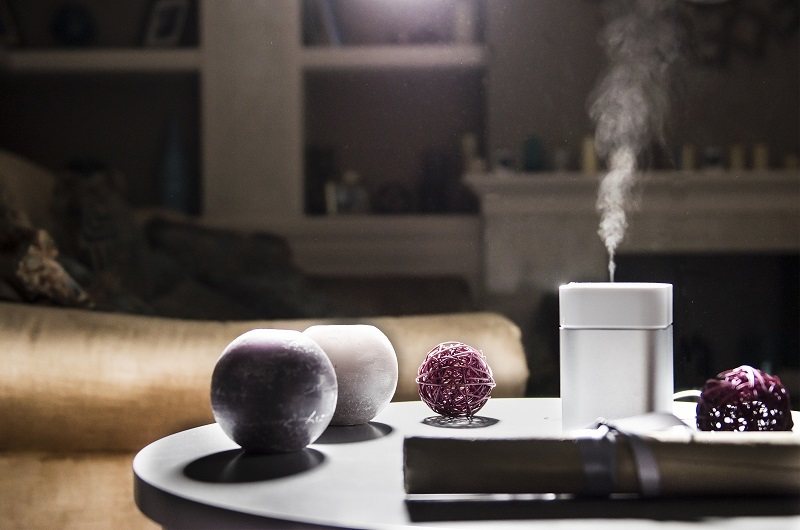However, it can be confusing when trying to find out how to use one.
What's even more bothersome is how little info there is out there to help.
Can you get harmful effects or perhaps feel worse if it is too near your bed?
And what about sleeping -- how can humidifier settings affect your sleep?
If you're wondering just how close you should place a humidifier for your bed, we have some advice that'll help.
Where Should You Place A Humidifier?
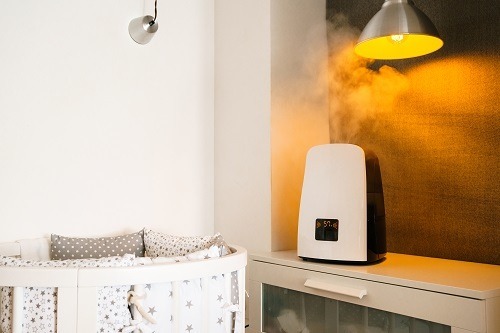
As it turns out, there is no one ideal place to place your humidifier.
We can, however, provide you some basic guidelines that will work for almost everyone.
We don't recommend you place a humidifier near your bed or other busy regions - but not for the reasons you may think.
In fact, during cold and sinus congestion cases, operating a humidifier could be beneficial alongside your bed.
Ideally, though, we suggest keeping your humidifier several feet from your bed on a good, flat surface over the floor where water droplets or clogs do not harm it.
Furthermore, if you're experiencing acute congestion, you might find it beneficial to keep it closer to the bed - but just temporarily.
As we mentioned earlier, an excellent guideline is to place humidifier several feet from your bed and other large furniture items under ordinary conditions.
When you're sick, having one placed next to your bed isn't just acceptable, but you can even inhale the soothing warm mist for relief.
While Sleeping at Night
When attempting to sleep, it is sometimes best to have a humidifier located far away from your bed.
While they generally won't hurt anything if too close, it is far better to have them located where moisture could be dispersed throughout the air before it reaches your lungs.
Furthermore, some humidifiers make noise while working that can wake light sleepers.
If you're a heavy sleeper, you're unlikely to have problems waking up when sounds happen. However, you should be aware that some humidifiers produce some weird sounds during operation.
For instance, when opening the water tank valve to retrieve more water, some make a "gurgling" sound. Others make a small bubbling or very low-volume noise due to the air moving through the unit.
Not only that, as a general rule we do not advocate having a powerful supply of moisture near your face when sleeping, as it is potentially bothersome to your nose & throat.
Additionally, as your body temperature fluctuates during sleep, you can become uncomfortable if the humidity gets too high. Condensation is a real issue.
Avoiding The Sun - And Cleaning
As we mentioned, do not set humidifiers in the direct sunlight, such as close to a window. It will support the growth of bacteria and algae, which will require you to clean the tank more frequently.
Maintenance is always required. Gradually (once per week or every two weeks), wash the tank thoroughly with a combination of white vinegar and water. Use a soft cloth to wipe off the interior of the tank as you go.
Don't Use Detergent
You will great results using distilled water as it helps maintain the buildup to the smallest amount of work possible.
Should A Humidifier Be On The Ground Or A Table?
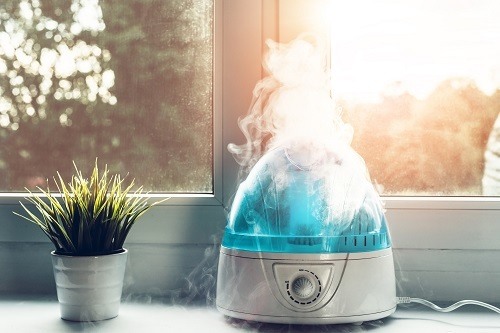
You can use humidifiers on a table or on the ground, although about 2 feet above the ground is generally recommended.
Humidity will distribute evenly throughout your room’s air, with time.
Product manufacturers also recommend not to use a humidifier alone without something to protect the surface from spills or water droplets.
Placing your unit at least two feet above the ground is best. In this situation, use a sturdy table that is not at risk of tipping with a thick and full water tank. You also don't want your kids or pets to accidentally tip it over, so be careful where you put it to prevent accidents.
Ideally, place some form of protective or tray material underneath your unit, as you will discover that it's relatively easy to spill water accidentally when replacing the tank.
In my experience it is a frequent problem, though it depends upon the design of your specific item.
Not everyone has a waterproof table to use, so feel free to use any water-resistant material. Pick one that's big enough to cover the region around the base by about 1/2 -- 1 foot in size for a rule.
You can use a humidifier on either the floor or a desk if you must. They'll still do the job, just less fast and economically.
One warning though: never place a humidifier on the carpet, as carpets tend to trap water and can possibly cause more problems.
How Humidifiers Work: Moisture, Air and Your Home
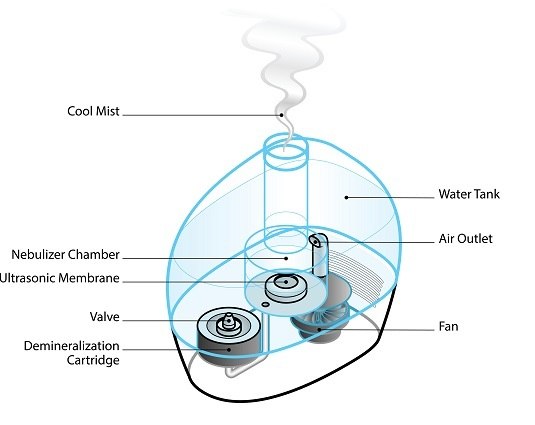
Although the precise details differ from model to model, all humidifiers do the same basic job: liquid water, kept in a tank, is transformed into a wonderful mist that rises in the atmosphere.
This increases the air’s humidity comfortably and safely.
Simply put, a humidifier functions to convert liquid water into a fine mist released into an area to raise the humidity.
While not all need electricity to accomplish this, most (and often the best ones) do use electricity from a standard electrical outlet.
Most humidifiers also use electrical power to vaporize water. The vaporizer is usually one of three types:
Of these, ultrasonic (cool mist) and thermal (warm mist) forms are the most frequently sold. Both have pros and cons, which we will discuss below.
A vaporizer alters the liquid form of water into a fine mist, which exits through an exit door and from a nozzle an is released into the room's air.
This adds humidity to the area's atmosphere and enhances comfort, health, and relief from low-humidity problems.
Basic Operation
The great news is that humidifiers are among the simplest appliances to use.
Operating one is easy - it boils down to a few simple steps:
Ultimately, you'll have to refill the water tank occasionally as it takes a few hours to get a tank to run out in many cases.
Some standard time windows are approximately 9 hours to 24 hours between refills. The amount of time depends on the humidifier's output and the tank dimensions.
For this sole reason, it is not always better to purchase the cheapest model. If you do not like to refill too often then spend a few more bucks for a version with a larger tank - it is truly worth it!
This is particularly true for overnight use during the winter or for all day use in dry climates.
How To Know When You Require A Humidifier (And How To Check)
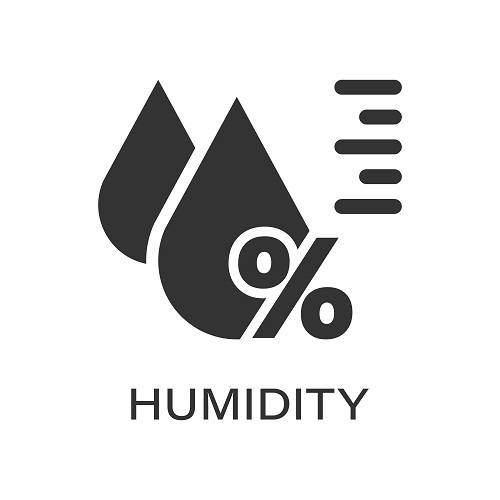
Two of the most frequent questions we get about humidifier operation include:
"What humidity level is best?"
and,
"How do I tell the humidity level in my house or room?"
Great questions!
Humidity is measured on a 0-100% scale and is relative to the atmosphere's temperature.
Thus the name you frequently hear, "relative humidity."
Generally, the human body feels best when the air’s relative humidity is above 30% and below 60%.
Although the ideal range for humidity in a house is 40-50%, your objective isn't to have it perfectly set to a predetermined number - that is neither realistic nor necessary.
Severely dry air conditions start to become evident at about 30 percent and below. In dry climates and during winter, humidity can fall to under 20%.
You might not know it, but allergy symptoms are less annoying if the atmosphere is kept to a healthy moisture level. That is because dry air permits pollutants to eventually become more of an issue and move about more freely.
How To Check Humidity Levels
Unfortunately, guessing is a terrible approach to learning about the air condition around you.
To make things worse, our bodies are designed to change how they feel in different temperatures.
While there are a couple of traditional methods to check the humidity in your room it is ideal to use an electronic humidity gauge.
Because relative humidity is tied to temperature, it's far better to have the ability to see both of these anytime you want to.
That is another reason these modern (and affordable -- most are under $15) tools are fantastic to get around.
You can observe the connection between the rise and fall of humidity and temperature right at any day time or night.
Humidifier Types
While similar in the way they look from the outside, there are some significant differences to understand between the major types of humidifiers sold today.
Here are 3 types of humidifiers for home and private use:
Warm mist and cool mist are similar but have some unique differences.
Evaporative models are less popular but have some pros and cons that the other two do not have.
Humidifier Type Differences
1. Warm mist models generate water vapor using electricity to produce heat and make a mild, low-temperature vapor that is a kind of steam. These are the best choice for colds, congestion and wintertime.
The drawback is they add warmth to a room as the water mist discharged warms until it escapes the unit.
Also, they do not have a dial controller like cool mist models and frequently have had 1 or more fixed output levels.
2. Cool mist models generally utilize low-power systems like an ultrasonic device to generate a great mist at room temperature.
These units are excellent for saving energy and are particularly well-suited to dry climate use.
They also feature near-silent operation, and several models allow for finer output level controls.
3. Evaporative humidifiers work as you might guess: water evaporates (enabled by a fan) with a unique design meant to increase the humidity in a room.
One characteristic of evaporative humidifiers is that they can't increase a room's humidity level as much as other types (for example, over 60%).
This is difficult to do, because as they release moisture it usually fills the void left because of low humidity thanks to the laws of physics.
Guidelines For A Baby's Room

The great news is that the same guidelines apply for your kid's room, too.
Among the best types to use, though, are a kid's cool mist model that is highly adjustable.
There are a few points we need to add, however:
Additionally, we suggest picking up a quiet unit so your child can sleep peacefully.

